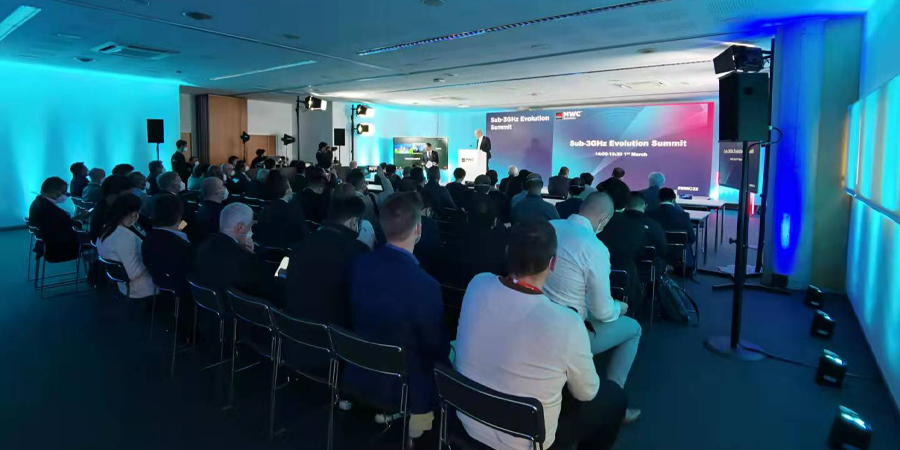Sub-3GHz is emerging as a valued spectrum to facilitate a 5G evolution. For operators, innovative upgrades to network featuring multi-antennas MIMO, ultra-wideband and multi-RAT coordination unleash the full potential of sub-3GHz. At the MWC Barcelona 2022, this topic took center stage as leading operators and partners in the telecom industry convened at the “Sub-3GHz Evolution Summit”.
Sub-3GHz to empower ubiquitous 5G experience
Sub-3GHz, an important band in 2G, 3G and 4G, offers good propagation performance as well as wide and in-depth coverage, both indoors and outdoors. For the majority of operators dealing in a multi-RAT environment, multi-antennas MIMO, ultra-wideband and multi-RAT coordination adoption canaddress fast LTE traffic growth and pave the way to a 5G future.
Shedding insights on the global 5G market, Alex Sinclair, GSMA CTO shared in his speech that 5G users will reach 2.3 billion by 2025. This represents a quarter of all users worldwide, while half of the users will be on 4G.
Noting that the existing sub-3GHz spectrum evolution is the fastest and most efficient way to provide wide 5G coverage, Sinclair indicated the importance of “migrating all sub-3GHz spectrum bands to 5G to create ubiquitous user experiences that add value for the industry”. This will also provide the long-awaited boost for VoLTE and VoNR to offer seamless video experience and coverage to the society, forecasted to reach 5 billion mobile connections in 2025, or 60% of all mobile connections.
“Sub-3GHz offers better user experiences on both legacy and future 5G networks”, said Stefan Zehle, CEO of Coleago. “Operators require a mix of spectrums, including sub-1GHz spectrum for seamless 5G coverage and speeds covering rural, urban and inaccessible areas.” Since modern radios are compatible with both 4G and 5G, and capacity can be allocated using dynamic spectrum sharing (DSS), operators transiting from 4G to 5G benefit from reduced cost per bit.
Ultra-wideband, multi-antenna and multi-RAT coordination for successful 5G evolution
There is a consensus that operators achieve better coverage and performance, higher spectral and energy efficiency when adopting ultra-wideband, multi-antenna and multi-RAT coordination solutions.
Carlos López Calvo, manager of wireless,Telefónica Group, spoke in-depth about the operator’s 5G evolution to integrated FDD and TDD coordination, as well as successful partnerships forged in operating markets.
In collaboration with Huawei, Calvo noted that Telefónica achieved the world’s first FDD 8T8R antenna and BladeAAU deployment in Germany. This all-in-one antenna for 5G helped Telefónica reduce site total cost of ownership (TCO) by 30%, increase coverage by 40% and improve user throughput by 30-70%. In Vivo Brazil, LTE FDD massive MIMO has been deployed at more than 500 sites, resulting in 5 times the capacity gain and 4 times the experience gain, as a positive first step toward 5G FDD massive MIMO.
Having bagged the Opensignal Mobile Experience Award in Spain, Calvo stressed that “the right combination of rollout strategy and optimization activities has enabled Telefónica to stay ahead of competition”.
Recognizing the need for coordinated efforts, Calvo called for the industry to adopt higher order MIMO like 6R&8R on both network and terminals for spectral efficiency improvement.
Reiterating sub-3GHz as the wireless foundation, George Held, chief of staff, VEON Group, shared that operators should enhance 4G and continuously evolve to 5G. This evolution requires “optimal use of spectrum and adoption of contemporary solutions- 4T4R/8T8R/massive MIMO ultra-wideband and multi-antenna solutions.”
George Held added that as part of VEON Group’s future network strategy, all bands are migrating to 5G, with 4T4R in low band, 8T8R /massive MIMO in mid-band and spectrum refarming to strengthen LTE and build a future-oriented 5G target network. In Pakistan, VEON’s flagship use of extensive massive MIMO has also helped deliver unique user experience.
On a similar note, Rob Sewell, chief technology strategy officer, Maxis, noted that its network is transitioning from traditional 2T2R /4T4R to tri-band FDD massive MIMO.
“Compared to previous MIMO solutions, tri-band FDD massive MIMO enables greater capacity gains and enhanced user experiences. It significantly reduces peak hour network loading and supports the seamless migration to 5G,” added Sewell.
Meanwhile, Bi Qi, Ph.D, chief expert of China Telecom said, “China Telecom has built more than 700,000 5G sites on its dual-band 2.1 GHz and 3.5 GHz networks. Multi-antenna technology has been instrumental to improving spectral efficiency and multi-frequency combination has been beneficial for maximizing energy efficency”.
In a vibrant panelist discussion, Jorge Luis Herrera, head of RAN, Entel Peru, reiterated that user experience is a key driver for operator’s success. “Sub-3GHz can be used with carrier aggregation with other bands to improve user experience. In fact, in regions with sub-3GHz sufficient spectrum, sub-3GHz can replace C-band to provide coverage and capacity, and reduce CAPEX by half.”
In view of the current sub-3GHz network innovation, Gavin Wu, senior advisor, Globe Telecom raised the “importance of harmonizing spectrums”. Currently, Globe is evolving from 2T2R to 4T4R in low band to increase download (DL) throughput. Leveraging innovative algorithms and machine learning, the 4T4R solution can shift LTE customers, camping on low-band spectrum near the cell, onto mid-band spectrum.”
Finally, Mohamed Madkour, VP of global wireless networks marketing and solutions, Huawei, spoke at length about Huawei’s FDD Gigaband MIMO Series, a breakthrough innovation that clinched the “Best Mobile Network Infrastructure” at the recent GSMA GLOMO Awards.
The multi-antenna technology maximizes spectral efficiency and enhances uplink experience. Ultra-wideband technology provides multi-band combination, ultimate simplified and green networks. According to Madkour, Huawei’s innovative ultra-wideband features natural cooling to achieve energy savings by about 28%.Software-defined multimode technique helps operators easily evolve networks to maximize return on investment.
Multi-antenna, multi-mode, as well as simplified green sites, is the long-term principle of global mobile infrastructure as operators embark on network transformations.
Through multi-band integration, Huawei’s FDD Gigaband MIMO series will support spectrum and technological evolution, and steer the industry towards a successful 5G-oriented sub-3GHz evolution.





